



Ashleigh Squirrel Rescue
SQUIRREL SUPPORT - The National Squirrel Rescue & Appreciation Society
Welcomes you!
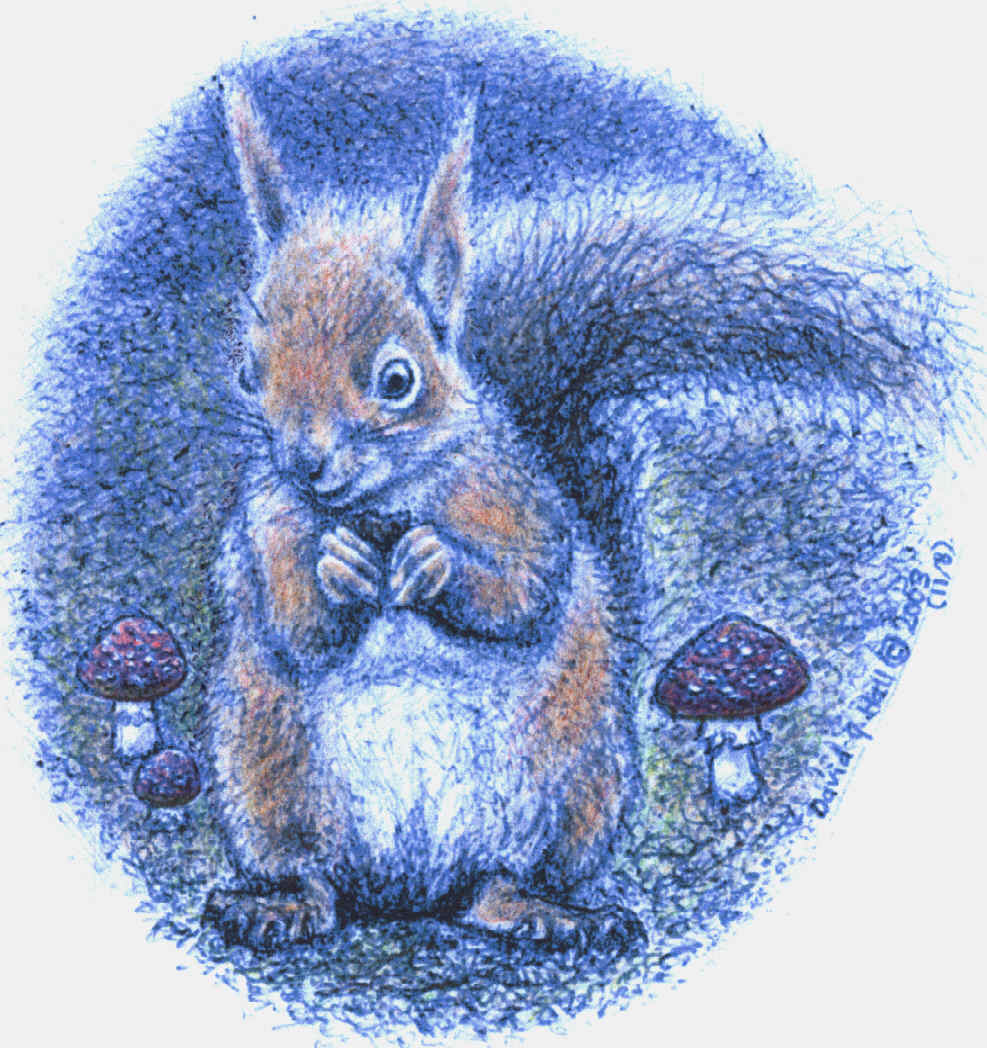
(ASHLEIGH) SQUIRREL SUPPORT'S TWENTIETH ANNIVERSARY!! 1995 - 2015
20th Birthday - September, 2015!
Please send donations, or Write to: Ashleigh Squirrel Rescue, (The Secretary), c/o "Lyndale", 23 Linden Road, HINCKLEY, Leicestershire, LE10 0AR.
Telephone: 01455 614 013.
NOTICES: 1.) There was previously a problem with the normal e-mail address, when we were unable to access that account - thankfully, that problem seems to have been resolved! People are still welcome to use this other one instead - which has been temporarily "borrowed" from the main charity's children and young peoples' section - thank you! Please e-mail: alexiaryartist1979@gmail.com
We apologise if anyone has written to the other one, and not received a reply as yet. This is currently a peak time for squirrel babies or juveniles, and as such, the Society is struggling to keep up with the huge demand and surge of calls/ messages for help, coming in - please bear with us on this!! It does receive messages and calls from many distressed people - and tries hardest to help.
2.) The Society wishes to thank all people who have so very kindly donated to the Recovery fund, following all of the terrible damage to our main base facilities in 2012! The property suffered thousands of pounds of damage, and this has been both very stressful and heartbreaking, to say the least. There is still a long way to go, however we have now already started to properly re-build, so please if you can make a donation - every penny really does count!
For the rescue, care and rehabilitation of sick, injured, orphaned and abandoned Squirrels and Chipmunks, (and Hedgehogs).
Hello and Welcome to our web site! The aim of this site is to provide a rescue contact for anyone who finds a sick, injured or orphaned squirrel or litter of Squirrels and/or Chipmunks in need of help. We also aim to provide something for all squirrel and chipmunk lovers to enjoy, (see below - Membership). Our charity has now reached a very special milestone! Squirrel Support: Ashleigh Squirrel Rescue (National Squirrel Appreciation & Rescue) was formed back in September, 1995, when it became clear that there was no appreciation Society for squirrels and we are the only squirrel charitable organisation of its kind in the UK. During the past twenty years, we have had great success in working with both wild and captive/"pet" squirrels - of a number of different species, saving hundreds of wild animals every year! Not only have we provided a local rescue and carer service in the area we are based, but we also successfully created link-ups with callers and their local wildlife rescuers, throughout the country and beyond, which we have been very successful at doing. We collaborate and work closely with leading Vets and other wildlife rescue and welfare organisations, such as the PDSA. The Society or charity can also take-in Hedgehogs. We have noticed that our charity has also been called other names by many people - examples include "The Squirrel Trust", or "The Squirrel Society" - these are names that have been used to describe us by other people - however, please don't confuse us with any other charity which may be using those names. Please also note that our own Volunteers with hospital facilities - based in Nottingham and Leicestershire, include both indoor and outdoor units - such as intensive-care incubators, aviaries and enclosures.



SQUIRREL & CHIPMUNK RESCUE...
It's SQUIRREL & CHIPMUNK BABIES season again! Please be aware of our contact details (above), just in case you find any orphans or babies in trouble! Many babies (known as "kittens") end up falling from their nursery drey, and are also often found in lofts or roof-spaces. Every year, we get inundated with calls from all over the UK about baby squirrels (kittens) needing help, during the Spring, Summer and Autumn periods! We also receive many messages for help about baby squirrels and chipmunks in distress from around the world in e-mail, including from within all the US States and Canada. We do try our best to advise - please note that young and sick squirrels and chipmunks are very susceptible to cold. When found in the wild in need of help, they need constant warmth.
Here on this page we have tried to give you the needed information about what to do if you find any babies or sick/ injured Squirrels (and Chipmunks) in need of help - this generally applies also to other baby, sick or injured small mammals, such as hedgehogs. They will likely be suffering from shock, they need WARMTH - EXTREMELY IMPORTANT!! Please note that if the Mother squirrel is still around, she may try to collect her young and carry them back to her nursery drey. She will respond to the babies' cries and be kicking up a fuss. In this case, it may be best to watch at a distance nearby and wait for her to collect them up. If after two hours still no Mother squirrel, they will definitely need to be rescued. IF, however, the babies (or baby) are stone cold and weak, on the ground, and their Mother is nowhere to be seen, then it is likely that they have been orphaned (Mother squirrel has been killed) or abandoned - again, rescuing them will definitely be needed. Having said all of this, remember that if there are cats around or it is raining, baby squirrels do not survive for long when out in the open. When in doubt, it is best to get expert advice.
! BABY / YOUNG SQUIRRELS AND CHIPMUNKS ARE VERY SUSCEPTIBLE TO COLD!
HYPOTHERMIA KILLS SQUIRRELS! Cold and/or wet squirrels are likely to die. Baby or young squirrels cannot tolerate temperature changes of more than a few degrees at a time.
IN AN EMERGENCY....
Get a small cardboard box or similar container and a hot water bottle. Fill up the bottle as you would for yourself, and then wrap it in a jumper or similar. You need plenty of gentle, soft material and place this in the bottom of the box, right by the well-wrapped hot water bottle; Hot - CAREFUL! (this is why it needs to be well-wrapped). Soft, absorbent tissue or kitchen paper on top of this makes an ideal temporary nest bedding, too - which is also useful when you need to remove faeces/urine quickly. Then (wearing gardening-gloves), very carefully put the squirrel(s) in the box. Covering the casualty(s) with an additional piece of toweling will help to keep him/her/them warm. This provides an ideal temporary heat source, until a wildlife rescuer in your area collects the baby or babies, or casualty. If at all possible try to avoid using towel material as the bedding, because the squirrel or chipmunk could get its claws tangled in the loops or any loose threads.
! YOUNG / JUVENILE SICK SQUIRRELS ARE LIKELY TO TRY TO BITE YOU WHEN FRIGHTENED. USE GENTLE, GOOD, THICK GARDENING-GLOVES.If the baby or babies are not too weak and hypothermia has not set in, if hungry they will be squealing loudly for food! If you don't have any suitable milk-formula to hand straight away, the following method can be used.... Make up "International Re-hydration Fluid" - which is 2 pints boiled water (still warm), with 1 tablespoon of sugar or honey and 1 teaspoon of salt. Using an eye-dropper or syringe, draw up the fluid and place it in the side of the baby's/ casualty's mouth, and VERY CAREFULLY let it drip, making sure the animal is swallowing. (Stop IMMEDIATELY if the baby begins to cough.) This can be a life saver! However, this method should only be used in emergencies. Lectade mineral-replacement drink and similar products (available from vets) are a much better alternative for treating dehydration.
EXTREMELY IMPORTANT!! - To avoid starting Pneumonia by flooding of the mouth, DO NOT under any circumstances try to pump fluid into baby squirrels without contacting us first! And do try to avoid getting bitten!
! PLEASE DO NOT TRY TO DEAL WITH THE PROBLEM BY YOURSELF IF YOU DON'T KNOW WHAT YOU ARE DOING - CONTACT EXPERT HELP. VERY YOUNG BABY SQUIRRELS ("KITTENS") NEED TO BE KEPT WARM ABSOLUTELY ALL THE TIME - AND NEED TO BE FED EVERY 2 - 3 HOURS DURING THE DAY AND IN THE NIGHT!The average squirrel litter-size is three. Once baby squirrels we take in are warmed up and revived, we syringe-feed them every 2 - 3 hours, day and night, so please bear this in mind! Sick and/or injured squirrels MUST be given veterinary treatment immediately or as soon as is possible. They can be hand-reared successfully on formula milk products intended for kittens/puppies. Goats milk in combination with Cow's milk can also be used (in an emergency, if can't obtain powdered formulas straight away). Please be aware that baby or young squirrels need the correct amount and balance of Calcium and Vitamin D, to help prevent nasty seizures and bone disorders, both of which can cause death. A mineral-block (stone) can be used, like you would for a small pet, and there are Calcium supplements available - please ask your Vet if in doubt. Sherley's LACTOL (R) (kitten/puppy formula) or PetAg ESBILAC (R) milk-replacement (puppy formula) are widely used. Fox Valley (we are told is close or nearest to squirrel milk) and Esbilac are examples of the best formula-milk products available as far as hand-rearing just about any baby mammal is concerned (e.g. Esbilac also for baby hedgehogs), however, the much cheaper alternative that baby squirrels do very well on is Beaphar (formerly Sherley's) Lactol, which is available in most pet stores. Do not mix the formula-milk too rich, or this will cause diarrhoea.
Mix LACTOL at "kitten-rate" the ratio of which has just been changed (see NEW instructions on the container). This WAS 5 level scoops per pint of warm water; (converted to 1 + 1/4 scoops to a quarter of a pint). Make absolute sure that both animal and formula-milk are warm; if not the animal can't be fed properly or even won't feed at all.
Please note - once one type of milk is used or started on, it is best that it's NOT switched to a different type. Squirrel babies, if they are well and found in good time, are fairly easy to hand-rear compared with other mammal babies. They usually have quite a strong suckle. The babies MUST under any circumstances be kept in a constant source of heat, such as in an incubator (set at about 30 degrees Celsius), or on a reliable heat-pad at the same temperature, (if possible). This temperature applies for the hand-rearing of many small mammals. Kitten feeding bottles - available from veterinary surgeries and some pet supplier stores/shops - can be used for hand-rearing; although syringes can also be used. The feeding bottles have a rubber teat attached to the end, and some nursing kits have spare teats. If there are no holes in the teat, make three tiny holes using a red-hot needle (CARE!) and boil the teat before use each time. ALWAYS make absolute sure that you sterilise all feeding utensils when using for very young babies.
ALL FEEDING UTENSILS MUST BE KEPT SCRUPULOUSLY CLEAN!
All individuals and litters/family groups must be kept separately from each other, to avoid cross-infection. However, the same babies in the same litter can be kept together while still very young. At this tiny young age, known as "pinkies", they also need their bowels and bladder stimulating like their mother would have done in the wild. This process is called "toileting" and is essential. It can be done simply after each feed, using a piece of warm, gentle, damp cloth or tissue to tickle on and around the belly and below the tail. By the time the babies open their eyes at approximately 3 and a half to 4 weeks, this process may no longer be necessary - however, it is best to keep going until you are sure. Do not over-feed them and weigh them regularly, to make sure that they are gaining weight.
EXTREMELY IMPORTANT - DO NOT OVER-FEED THE BABIES; (SEE QUICK GUIDE BELOW)....
| FEEDING AMOUNT / DEVELOPMENT QUICK GUIDE FOR BABY SQUIRRELS (KITTENS) - USING A KITTEN FORMULA-MILK MADE UP FROM POWDER, (E.G. 'LACTOL' ): |
| 0 - 1 WEEKS:
0.1 - 0.5 ml., every 2 hours by day and every 3 hours during the night.
Time-period found from around late-February (at earliest we have recorded, Feb. 24, 2010)/beginning March
to April and late-July to August.
The newborn squirrels have no fur, are blind and deaf - called "pinkies". Loud, repeated
squeal when hungry. Tiny at newborn - only the size of your thumb! Definitely need "toileting" after each feed - bowel
and bladder stimulation very carefully on belly and below tail, using
warm, gentle damp material. 1 - 2 WEEKS: 0.5 - 1 ml., every 3 hours by day and every 3 hours during the night. Period around early-March to in April and late-July to August, or even into beginning of September. The fur colour just starts to show through on the skin. The tail resembles that of a rat, with very short hairs; (reddish-black on baby Red squirrels and white on baby Grey squirrels). Will still squeal very loudly! Need "toileting". Claws already well-developed by week two. 2 - 3 WEEKS: 1 - 2 ml., every 3 hours by day and every 4 hours during the night. Period around mid-March to mid-April and beginning to late-August or even into September. Fur starting to appear, giving a beautiful "velvety" appearance. By week 3, begin to look "fluffy". Continue with "toileting" if unsure, but some babies can stimulate themselves by this stage. 3 - 4 WEEKS: 2 - 4 ml., every 4 hours during the day and night, (but can increase the feeding interval overnight to approx. eight hours by week 4 - unless the animal is sick). Period around mid/late-March to mid/late-April and early-August to into September. Front incisors begin to appear - lower first. EYES OPEN (at 3 and a half to 4 weeks). IMPORTANT: Weight by now approximately 50 g. (Red Squirrel) or 90 g. (Grey Squirrel). Once the eyes have opened for the first time, the weaning process can begin. Offer little pieces of bread soaked in the formula-milk close to baby's face, (as they have poor close co-ordination). The babies becoming mobile and can start to climb, so a high-sided box or suitable container (with a lid) will be needed by now, in preparation! Make sure there are air-holes if it has a lid. 4 - 5 WEEKS: 3 - 4 ml., every 4 hours during the day. Sick babies benefit from night-feeds. Period around late-March/beginning April to late-April and mid-August to early/mid-September. By now, the baby should begin to try to nibble semi-solid foods, as well as being fed by syringe. Offer little pieces of bread soaked in the formula-milk, little pieces of fruit and some cereals. By week 5 you may notice the baby try to sit and nibble on a nut. The switch will seem to happen suddenly. By now they start to look like miniature squirrels, but with the tail only just starting to become "bushy". Becoming very mobile and with the claws well-developed, can start to climb out of smaller containers. Also begin to gnaw, and by now baby Red Squirrels will start to get their ear-tufts developing. 5 - 6 WEEKS: 4 ml., every 4 hours during the day. Sick babies still need feeding in the night, too. Period around beginning of April to beginning May and mid/late-August to mid/late-September. By this stage, fresh (filtered) water can also be offered using a syringe, as well as the formula-milk feeds. Pieces of bread still soaked with the formula-milk; but also offer cereals, crushed nuts (kernels only), fruit (e.g. apple or pear), crushed maize and sunflower hearts. Offer a variety of nuts - not just peanuts or almonds. Also Zupreem Primate dry biscuits to chew, (if can obtain this). Climbing around and gnawing much more obvious, now. After week 5 they begin to play, start to learn to groom themselves and the tail getting more bushy (but tapered), by week six. By now a suitable indoor "cage" with nest-box needs to be prepared (do not use towels). There may be an attempt to nip or bite, if a baby doesn't like being grabbed - CARE! 6 - 7 WEEKS: Over 4 ml. of formula-milk per feed - the squirrel will try to take much more than this each time, but you must offer solid and semi-solid foods, and fresh water. By now almost fully-weaned juveniles and are about half-grown; (some youngsters can wean as young as six weeks). Please be aware that oncoming colder weather can disrupt rehabilitation and releasing - some animals, especially ones that have been sick or badly injured, cannot be released or housed outside until in the following Spring - and some may be too sick or disabled to release, where legal or able to do so. 7 - 8 WEEKS: Most squirrels are weaned by this stage, fully by week Eight. Weight by now approximately 150 g. (Red Squirrel) or 280 g. (Grey Squirrel). They would have remained with or very close to their Mother for a further few weeks, in the Wild. NEVER move a young and/or recovered squirrel straight into an outside enclosure from being kept incubated - the squirrels need to be acclimatised first. 10 - 14 WEEKS: This is when young squirrels in the Wild become independent and start to disperse; use this as a guide when/ where able to (legally) release a squirrel back into the Wild, using the "soft-release" method - that is an enclosure with suitable housing that has open access. Never release squirrels that are blind or have misaligned front incisors. Do not release Red Squirrels where commercial foresters consider them a pest (yes - this does happen), where there are a lot of cats, during a drought or in the middle of Winter! Spring and early-Autumn are probably the best times. If in doubt, seek expert advice.
|
A SUCCESS STORY [FROM THE ARCHIVES]
During 2003 - '04, the above advice helped to save so many squirrel babies' lives up & down the UK and overseas! A lot of people struggle to find carers for their area and some of these callers travel many miles to bring a casualty, orphaned baby or family of babies to us, as we are considered a trusted and specialist rescue organisation for squirrels. Indeed, 2004 was our most busy and successful year so far, with casualties/orphans arriving from as far away as Nottingham, Retford and Manchester! About 90 % of these babies were successfully hand-reared and treated!
ASHLEIGH SQUIRREL RESCUE (SQUIRREL SUPPORT): MEMBERSHIP SOCIETY
FOR SQUIRREL AND CHIPMUNK LOVERS - EVERYWHERE!
As well as the rescue, hand-rearing and rehabilitation (where possible) of wild squirrels, we provide entertainment for all squirrel and chipmunk lovers to enjoy. All Members, Supporters and Volunteers receive our newsletter/magazine, the 'HOARDER', which is (usually) published several times a year - including in Summer and December. If you wish to join, please write and send donations (cash also accepted) to the address above or you can also e-mail: alexiaryartist1979@gmail.com
Please make cheques/postal-orders payable to "Foxwatch" or "Foxwatch/Squirrel Support". Please write to: Ashleigh Squirrel Rescue, The Secretary, "Lyndale", 23, Linden Road, Hinckley, Leicestershire, LE10 0AR, England, UK. All support is extremely appreciated!
A QUICK GUIDE TO THE STAGES OF GROWTH AND DEVELOPMENT - IN PICTURES....
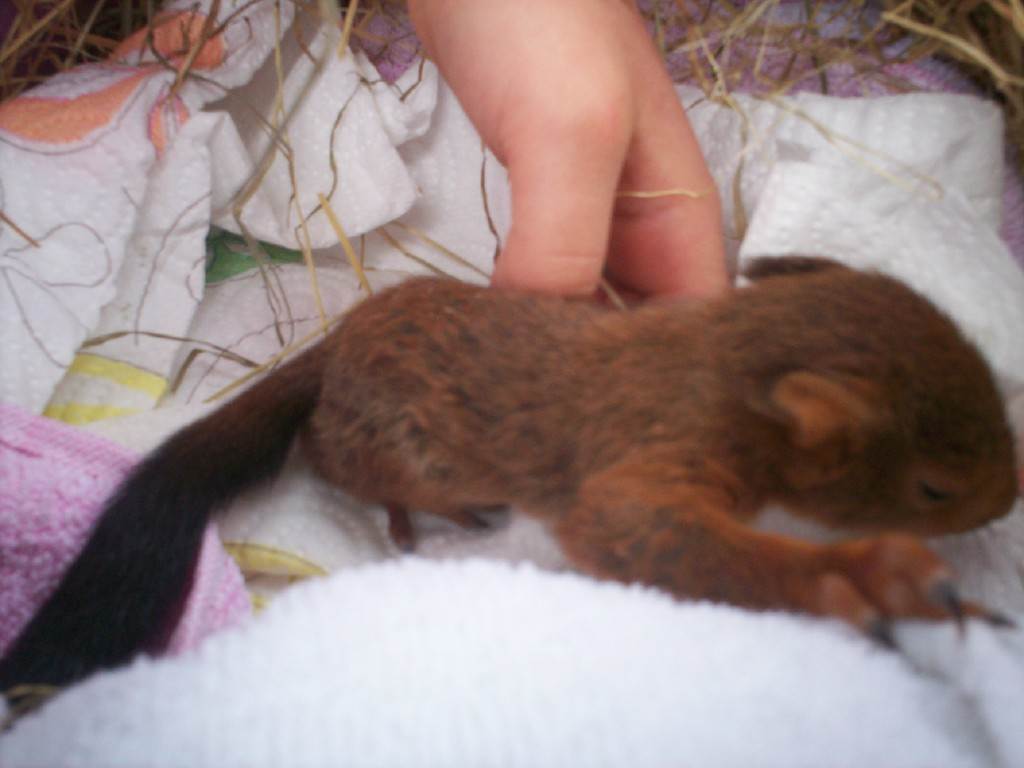 s
s
B
aby Red Squirrel (aged 3 + 1/2 weeks), - April, 2008 Baby "Sammy" (at aged 4 weeks) in Aug.,2002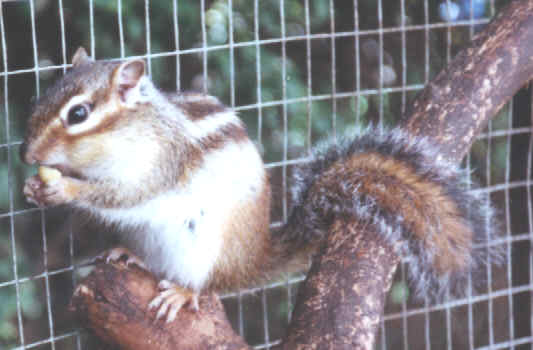

"Tufty" the Chipmunk - 1998 (left) and a Baby Red Squirrel, Spring, 2013 (right).


PET CHIPMUNK RESCUE & REHOMING....
We also have a national Re-homing and "Lost & Found" scheme for Chipmunks. These exotic squirrels are very popular indeed as pets, and the author of this site now has 25 years of experience with handling, breeding, hand-rearing and caring for chipmunks, as well as wild UK squirrels and other wildlife, such as hedgehogs and foxes. If anyone reading this would like a chipmunk (or chipmunks) for a pet, then we may be able to help you! We regularly have some available to re-homing; alternatively, if you need any taking off your hands because you can no-longer care for them, please get in touch! They will be cared for by us, until a new suitable home is found - or will be cared by us permanently, if needed. Advice on the care of chipmunks and/or other squirrels, also available - Please go to: Ashleigh Squirrel Rescue: Chipmunk Rescue. (Please note, this is a separate website - under Hogarth's Wild Life, [aka Hogarth's Wildlife Rescue]. This should cross-link to the earlier domain, hogarths-wildlife.org).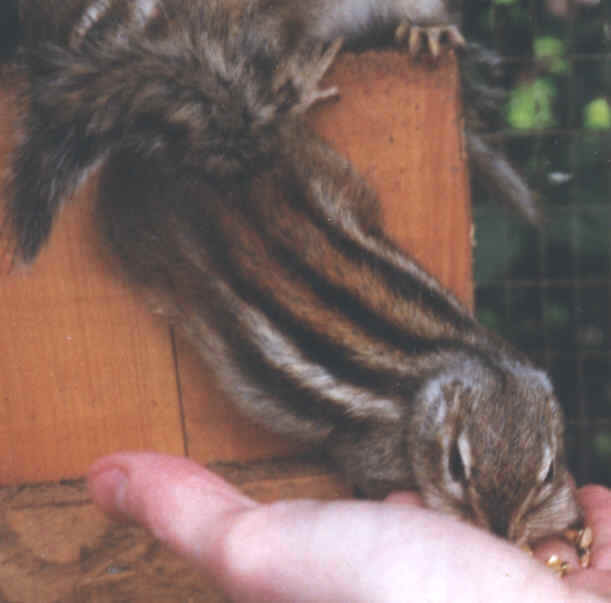
Lucy the chipmunk, feeding from my hand.
Unless otherwise stated, all text, photographs and artwork featured on this site are the property of Squirrel Support - National Squirrel Appreciation & Rescue and Hogarth's Wild Life/ Alexia. Squirrel Support is a sub-division of Hogarth's Wild Life/ Alexia. Copyright
© 1995 - 2015, All Rights Reserved.

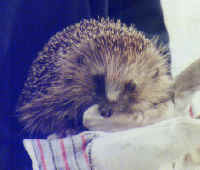 This
is a WILDLIFE FRIENDLY site!
This
is a WILDLIFE FRIENDLY site!
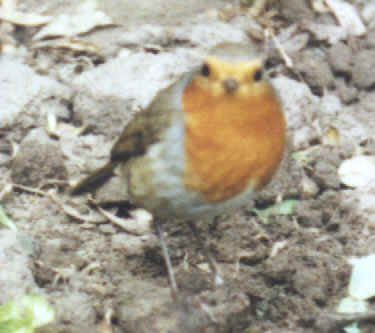


Alexia Arts 4 Kids - 701, Alexia's Blog, Chipmunk Rescue, Hogarth's Wild Life Main Menu